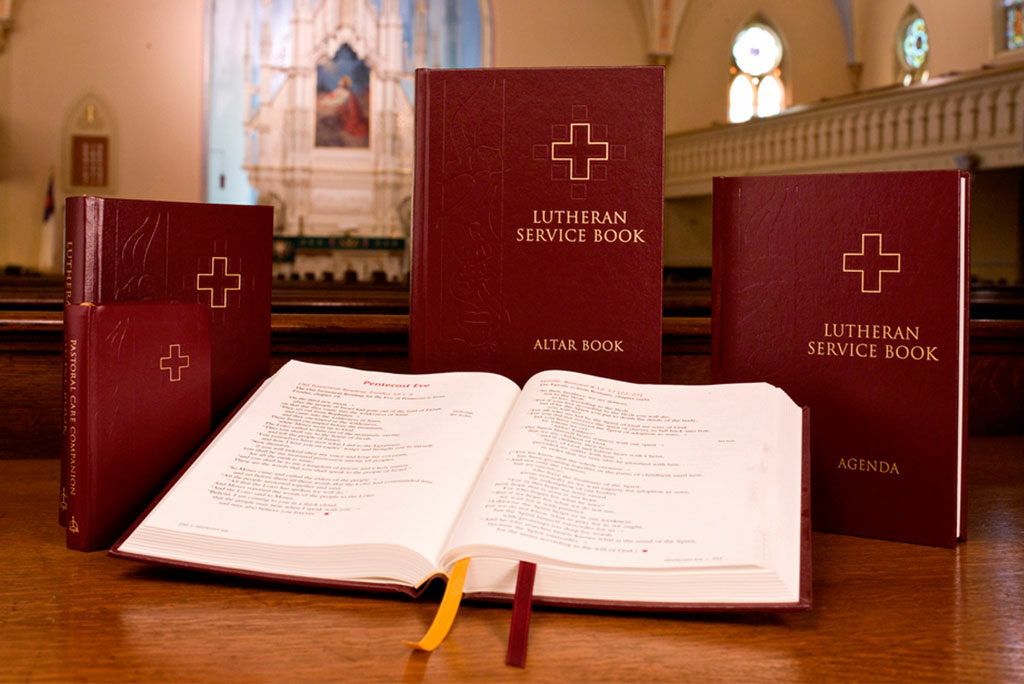Sunday, September 22, 2024
GDP Update
Wednesday, September 18, 2024
Gerhardt Daily Prayer
Friday, September 13, 2024
Suggestions for a New Hymnal
When Lutheran Service Book (LSB) was published in 2006, it was designed to be a unifying hymnal for the synod. Specifically, they wanted to get the vast majority of congregations behind a single book. At the time, I'm guessing the synod was primarily split between three worship resources: The Lutheran Hymnal, Lutheran Worship, and contemporary music. While the synod will probably never (again?) all worship from the same book and in the same way, they wanted to give it their best shot to appease both the TLH and LW folks, while also giving a nod to the contemporary congregations, all without sacrificing faithfulness and quality.
I came into the history of Lutheran hymnody pretty late in the game, since I was only born 9 years before LSB came out. My congregation growing up used TLH, but my father gave every member of our family an LSB, seeing the potential benefits in getting us used to the hymnal that most of the synod would be using, as well as the benefit of trying to use the same (new) Bible translation across the board - ESV.
Lutheran Service Book has become my favorite Lutheran hymnal, chiefly because it's the one I grew up with, and the one I continue to use. I don't necessarily think it's the best; one of the old books from the '20s or even Walther's Hymnal probably have it beat. But if the goal was to unify the synod without becoming unfaithful, I think the writers and editors of LSB did a fine job. The hymnal retains a great many treasures of Lutheran hymnody. It employs a genius numbering system to prevent confusion across sections. Its wide array of resources is eminently useful. Its liturgies are faithful and mostly beautiful. The pocket edition especially, which I've written about before, is just golden; I believe the first hymnal in our synod's history to contain all 150 Psalms.
At the same time, Lutheran Service Book has a number of weaknesses, mostly borne from their desire to create a unifying hymnal - trying to do a lot of things well often ends up meaning some depth and quality is lost. Specifically, here are the hymnal's weaknesses as I see them:
- Not having all 150 Psalms in the standard hymnal
- Too many orders of worship and divine service (the Lutheran Service Builder has made a lot of that simply unnecessary - a technological advancement that would not have been foreseen at the time)
- Too many third-tier hymns
- The amputation (shortening or eliminating) of too many first-tier hymns
- The lack of inclusion of other confessional documents
- Remove the Gloria Patri from the end of each Psalm. This is a space-saver. While the Trinitarian focus is commendable, it sometimes weakens and undermines that divinely-chosen ending of each Psalm.
- Remove Divine Service 2, 4, and 5.
- Remove either Responsive Prayer I or II
- Remove the service of Corporate Confession and Absolution
- Condense the "Prayers, Intercessions, and Thanksgiving" section, with only about half the prayers, but make them better quality drawing from one of the older versions of the Lutheran Book of prayer. make each prayer a bigger deal instead of just throwing a bunch in there.
- Remove 10-20 third-tier hymns, and any and all fourth-tier hymns
- Remove a few of the repetitive "liturgical music" hymns such as various ways to sing "Alleluia"
- Add the missing Psalms to include all 150
- Add another couple Psalm prayer plans in addition to the table for daily prayer; one for praying through them every 28 days.
- Keep Divine Service 1 and 3 and still call them those, then make a setting 2 that combines the best elements from 2, 4, and 5. Three is still plenty of options, but with the Service Builder out there, again, you don't need to try to tailor it to every person.
- Include a prayer for each day of the week in the Daily Prayer section, instead of just suggestions for topics.
- Add all the original stanzas to several 16th and 17th century hymns, with priority given to the best of Gerhardt and Heerman. Present the hymn with batches of verses split into and labeled with roman numerals, to encourage congregations to sing the whole thing split throughout their service. For instance, a 15-stanza hymn would be divided into I (1-5) II (6-10) and III (11-15).
- Add a handful of new hymns, with priority given to those which are of the highest quality and are most needful for the modern Lutheran at the time.
- Add the Unaltered Augsburg Confession
Wednesday, September 4, 2024
Pocket Notebook Ideals
When you use a tool on a very frequent basis, I think it's natural to form a strong opinion about that tool. For example, you probably have a pretty clear understanding of what you do and don't like about your phone, or your car, or your front door.
This is how it is with me and pocket notebooks. I use them daily, and I've used a wide variety of them. Not only that, but I enjoy them. Again, imagine how much thought a car guy would put into the car he drives every day.
Despite experiencing a resurgence, pocket notebooks are still small fries overall in the modern American consciousness. For those who do use them, each person forms specific preferences based on factors like their vocations, usage environments, most common types of note-taking, and writing instruments.
There are three priorities I've come to value and appreciate the most in my pocket notebooks.
First is durability. It is essential that my notebook remain intact, undamaged, and functional until it is filled. I've had too many notebooks with covers split along the fold, notebooks with pages that are susceptible to crumpling and tearing, and notebooks that are overly vulnerable to moisture. My favorite notebooks have reliably kept their shape in the pocket, being built with high-quality materials. They have had durable covers, resistant both to tearing and minor water exposure. And they have had high-quality pages that can endure some abuse.
Second is usability. My pocket notebooks need to be highly functional and reliable tools. It's best if the inside paper is amenable to a wide variety of writing utensils, whatever happens to be on hand, but usually my gel pen. The notebooks need to be small, thin, and flexible to fit in the pocket without discomfort or bulk. The pages need to be ruled with both written text and tables in mind, as well as the occasional coordinate plane. Graph paper is ideal for a wide variety of applications. Squares should be appropriately sized for my handwriting. It's best when the notebooks provide space for personal information, as well as other useful texts, tables, and writings.
Third is asesthetics. The best pocket notebooks not only work well, but look good. An elegant cover design is a big part of this - something you look at every day should have an element of beauty and good form. Choices regarding colors, photographs, artwork, fonts, etc. all play into the joy and pleasure of using these tools on a daily basis. I appreciate when my pocket notebooks give thought to unity in design. Attention to detail goes a long way in a small, simple product like a pocket notebook.
For me, Log and Jotter meets all three of my pocket notebook priorities, and I will continue using their products as long as they stay in business. Field Notes and Rite in the Rain are the other front-runners, but each has weaknesses that Log and Jotter has been able to solve.
My hope is that the soon-to-be-prototyped Endurance Logbook will build on and learn from the excellence of Log and Jotter, and offer something more specific: not just a great pocket notebook, but a great pocket notebook for Christian men. We are in a spiritual environment where every ounce of divine aid is desperately needed, and the Word and prayer are sorely lacking, despite easier and freer access than at any other point in human history. The Logbook intentionally brings the focus back to the Word and Sacraments, and to prayer and meditation. And I'm designing it to meet the highest standards for excellence in the intersection of durability, usability, and aesthetics. As an avid and opinionated pocket notebook user, it's an exciting prospect. My very first pocket notebook was homemade, and I've continued to grow and learn more about the design and construction of pocket notebooks. I think that the trial and error of my years in the "business" will help to yield an exceptional and invigoratingly fresh pocket notebook for those who, like me, highly value these little tools. Lord-willing, there will be an Endurance Logbook in your pocket some day!
Happy note-taking!
Monday, September 2, 2024
24-25 NFL Season Preview
Blog Archive
- November 2025 (1)
- August 2025 (2)
- June 2025 (2)
- May 2025 (1)
- April 2025 (1)
- February 2025 (1)
- January 2025 (2)
- December 2024 (4)
- November 2024 (4)
- October 2024 (4)
- September 2024 (5)
- August 2024 (1)
- July 2024 (1)
- June 2024 (2)
- May 2024 (4)
- April 2024 (3)
- March 2024 (2)
- February 2024 (11)
- January 2024 (5)
- December 2023 (6)
- November 2023 (7)
- October 2023 (3)
- September 2023 (5)
- August 2023 (2)
- July 2023 (5)
- June 2023 (4)
- May 2023 (7)
- April 2023 (8)
- March 2023 (5)
- February 2023 (10)
- January 2023 (12)
- December 2022 (16)
- November 2022 (20)
- October 2022 (16)
- September 2022 (19)
-
"It's hard to put my finger on it, but there's something viscerally satisfying about the entire Log and Jotter notebook exper...
-
Artwork from Kloria Publishing "A Mighty Fortress is our God" "All our shelter and protection rest in prayer alone." - ...
-
Last-minute Christmas gifts are bought and wrapped. Family travels to its traditional destination, or else waits for relatives to arrive. ...






